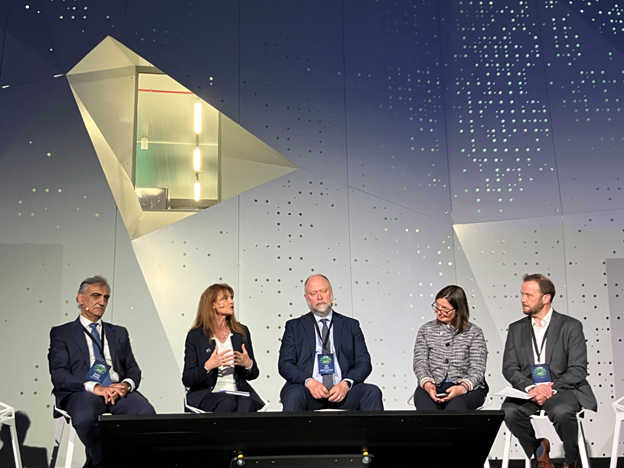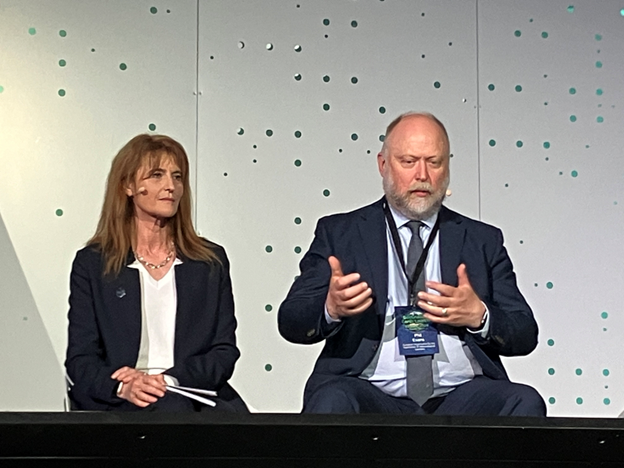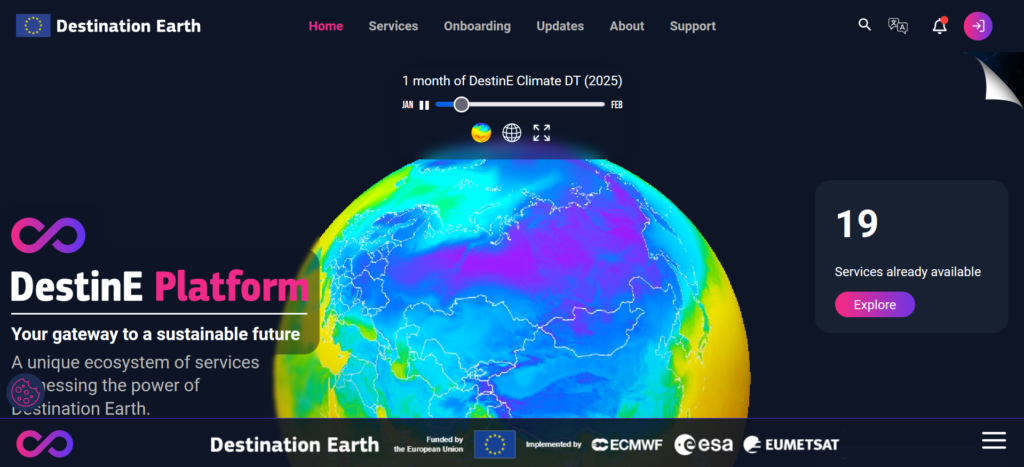Launch of Destination Earth system

The prestigious event attended by high-level representatives from the European Commission including Executive Vice-President Margrethe Vestager, major European entities and the Finnish Government, marked the official launch of this groundbreaking initiative to better understand our changing climate and extreme weather events.
The initial version of the DestinE system has now been launched. In less than two and a half years, the teams, involving more than 100 partners from countries all over Europe, have worked around the clock to assemble the main components. All visitors to the platform will have a glimpse into features demonstrating some of the capabilities of the system. Selected groups of users will soon have access to advanced services and unique datasets to test, improve and further develop the system towards its full operationalisation.
The official launch ceremony held at the EuroHPC JU LUMIOne of the EuroHPC pre-exascale supercomputers, hosted and o More supercomputing center in Kajaani, Finland, was opened by the European Commission Executive Vice-President Margrethe Vestager, the Managing Director of Finland’s CSC-IT Center for Science Kimmo Koski, and the Finnish Minister of Employment, Arto Satonen. It gathered high-level representatives of key European and international stakeholders, as well as the Destination Earth implementing entities (the European Center for Medium-range Forecasts – ECMWF, the European Space Agency – ESA, and the European Organisation for the Exploitation of Meteorological Satellites – EUMETSAT.
The speakers unveiled a number of major features and benefits of this new information system which exploits the latest breakthroughs in Earth system science and supercomputing in support of climate change adaptation.
At 13:30 CEST[RC1] on 10 June 2024 the Destination Earth system was launched officially.
“The launch of the initial Destination Earth (DestinE) is a true game changer in our fight against climate change.” said Margrethe Vestager, as she rang a historic bell from the time when the LUMIOne of the EuroHPC pre-exascale supercomputers, hosted and o More site was one of the largest papermills in Europe, marking the launch of the system.
DestinE will provide us with a highly accurate twin of the Earth. It means that we can observe environmental challenges which can help us predict future scenarios – like we have never done before. This first phase shows how much we can achieve when Europe puts together its scientific excellence and its massive supercomputing power. Today, the future is literally at our fingertips.”

The LUMI supercomputer, hosted by CSC IT Center for Science, is one of the extreme-scale computing systems used in DestinE thanks to the strategic access awarded by the EuroHPC Joint Undertaking (EuroHPC JU). In addition to being Europe’s most powerful system (#5 in the TOP500 list) it is also one of the greenest and is currently being used for running simulations of the Climate Change Adaptation and Weather-induced Extremes Digital Twins of Destination Earth.
The ceremony started with a welcome address by hosts Kimmo Koski, Managing Director at CSC-IT Center for Science, and Arto Satonen, Minister for Employment of Finland along with Commission Vice-President Vestager, after which officials from the EU Commission’s DG CONNECT, EUMETSATEuropean Organisation for the Exploitation of Meteorological, ECMWFEuropean Centre for Medium-Range Weather Forecasts More and ESAEuropean Space Agency explained some of the details of the fast-paced implementation of DestinE.
A visionary new system for supporting decisions in a fast-changing climate
Underpinning the importance of robust climate information systems, the previous week the United Nations Secretary General gave a Special Address on Climate Action, coinciding with the release of new data by the Copernicus Climate Change Service, confirming an unprecedented streak of global temperature records.

During the panel The Road to the Launch Florence Rabier, Director-General of the European Centre for Medium Range Weather Forecasts said: “In our time of climate crisis, Destination Earth is a groundbreaking initiative to benefit society. For fifty years ECMWFEuropean Centre for Medium-Range Weather Forecasts More in collaboration with its Member States has been at the cutting edge of using high-performance computers together with large Earth Observation data, modelling and now artificial intelligence to create value for society through weather forecasting and climate. We are proud to utilise this expertise in creating the first digital twins of DestinE.”
ECMWFEuropean Centre for Medium-Range Weather Forecasts More, together with a team of partner organisations from leading climate science centers, national meteorological services, research institutions and supercomputing centers in Europe, has built the first two high-priority digital twins on Climate Change Adaptation and Weather-induced Extremes, as well as the Digital Twin Engine of Destination Earth, which supports the complex operations of the digital twins on the EuroHPC systems and allows to handle their vast amounts of data.
Director-General of the European Organisation for the Exploitation of Meteorological Satellites Phil Evans explained the work to build the DestinE DataEarth-system monitoring and prediction system output as prov More Lake, the system providing access to the digital twins’ data, but also providing the opportunity to process the data online. The Data Lake will include access to data from other sources, including Earth Observation data, but also socioeconomic data sources, in addition to data from the DestinE digital twins.

“Today is an important milestone towards empowering Europe with a new tool to foster resilience and fact-based decision-making. I would like to congratulate all the teams involved in this major achievement, mainly those from EUMETSATEuropean Organisation for the Exploitation of Meteorological who developed the Destination Earth data lake. This technological innovation underpins the entire initiative: enabling interoperability between separate datasets and accelerating our ability to cross-reference different types of information, to deliver impactful models and answers in an easy way to user communities.” said Phil Evans.
All visitors to the platform will have a glimpse into features demonstrating some of the capabilities of the system, while selected groups of users will progressively access the system via DestinE PlatformSelf-standing DestinE system component, interfacing with the More, the innovative access point developed by the European Space Agency that includes services for viewing, processing, and visualising DestinE data but also data and information from across the European ecosystem of Earth observation services.
Simonetta Cheli, ESAEuropean Space Agency Director of Earth Observation Programmes said: “Destination Earth is a flagship initiative that builds on European modelling capabilities and also on Earth observation data. We, at ESAEuropean Space Agency, are thrilled to contribute to this new era and proud to be responsible for the DestinE PlatformSelf-standing DestinE system component, interfacing with the More. The platform provides a rich range of applications and services, which will progressively become accessible to everybody, and creates a new flexible and scalable ecosystem.”
Josephine Wood, Head of Unit Strategy and Governance, EuroHPC Joint Undertaking completed this introductory panel, explaining how all the participating EuroHPC JU supercomputing systems contribute to the initiative, and how the EuroHPC JU will keep working to satisfy the computing needs of its users.
Inside the DestinE system
DestinE is a truly European effort that gathers technology and savoir-faire from operational, research and supercomputing centres from across Europe. The system has been codesigned with selected users to ensure it serves the needs of the sectors most impacted by climate change and weather extremes.
In this initial version, the first selected groups of users accessing the DestinE PlatformSelf-standing DestinE system component, interfacing with the More can explore and process the data generated by the first two digital twins’ simulations. The platform provides access to an ever-growing number of innovative data services and it’s the gateway to enter the community, either as a user or as a service provider.

The digital twins “runs” are launched by the scientists in charge of the simulations using the supercomputer systems provided by EuroHPC JU; LUMIOne of the EuroHPC pre-exascale supercomputers, hosted and o More, hosted by CSC (Finland) and the LUMIOne of the EuroHPC pre-exascale supercomputers, hosted and o More consortium, Marenostrum5, hosted by BSC (Spain) LeonardoOne of the EuroHPC pre-exascale supercomputers, hosted and o More, hosted by Cineca (Italy), and MeluXina, hosted by LuxProvide (Luxembourg). The digital twin Engine enables both the operation of the digital twins in the EuroHPC JU systems and an effective access to the huge volumes of data generated by the digital twins’ simulations.
The Data Lake allows users to access, process, and combine the digital twin data with other information sources to serve their needs, including datasets generated by the Copernicus programme, ECMWFEuropean Centre for Medium-Range Weather Forecasts More, ESAEuropean Space Agency and EUMETSATEuropean Organisation for the Exploitation of Meteorological. Implemented on a distributed cloud infrastructure close to EuroHPC and beyond, it is designed to provide highly scalable storage and cloud computing capacities.
After the official launch, a second panel with representatives of key stakeholders of DestinE (Barcelona Supercomputing Center, European Environmental Agency and the Danish Meteorological Institute) discussed the key features of the new system, their expectations for the future and the added value of DestinE in the landscape of Earth system information providers.
Through video messages, representatives of research organisations, policymakers or the renewable energy sector described their needs and how the DestinE system could help them in their daily work.
Boosting European supercomputing, Earth system science and artificial intelligence
With the European Union making machine-learning and artificial intelligence (ML/AI) a key priority, DestinE is also leveraging the fast-paced advances in ML/AI to provide uncertainty quantification for the simulations, enhance the interactivity of the system and ultimately develop workflows towards a ML foundation model for the Earth system.
Boosting European ML/AI is a key objective of DestinE in its second phase (2024-2027) and the launch event concluded with an open discussion led by Margrethe Vestager in which early career scientists discussed their views on ethical and responsible artificial intelligence and the vast opportunities that ML/AI opens for the next generation of Earth system information systems such as DestinE.